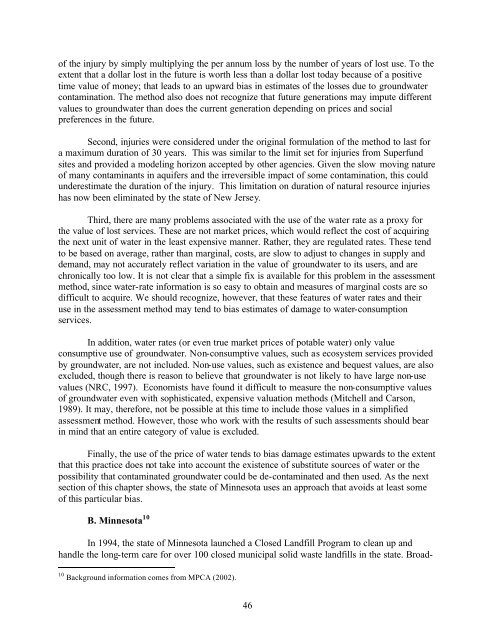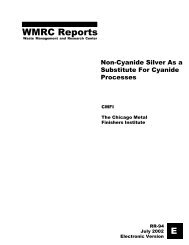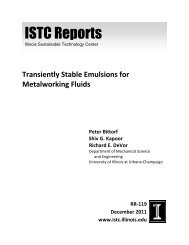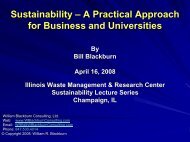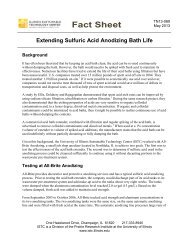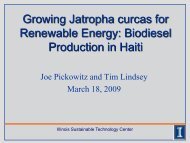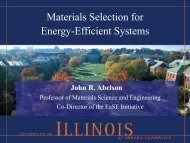Natural Resource Damage Assessment: Methods and Cases
Natural Resource Damage Assessment: Methods and Cases
Natural Resource Damage Assessment: Methods and Cases
Create successful ePaper yourself
Turn your PDF publications into a flip-book with our unique Google optimized e-Paper software.
of the injury by simply multiplying the per annum loss by the number of years of lost use. To the<br />
extent that a dollar lost in the future is worth less than a dollar lost today because of a positive<br />
time value of money; that leads to an upward bias in estimates of the losses due to groundwater<br />
contamination. The method also does not recognize that future generations may impute different<br />
values to groundwater than does the current generation depending on prices <strong>and</strong> social<br />
preferences in the future.<br />
Second, injuries were considered under the original formulation of the method to last for<br />
a maximum duration of 30 years. This was similar to the limit set for injuries from Superfund<br />
sites <strong>and</strong> provided a modeling horizon accepted by other agencies. Given the slow moving nature<br />
of many contaminants in aquifers <strong>and</strong> the irreversible impact of some contamination, this could<br />
underestimate the duration of the injury. This limitation on duration of natural resource injuries<br />
has now been eliminated by the state of New Jersey.<br />
Third, there are many problems associated with the use of the water rate as a proxy for<br />
the value of lost services. These are not market prices, which would reflect the cost of acquiring<br />
the next unit of water in the least expensive manner. Rather, they are regulated rates. These tend<br />
to be based on average, rather than marginal, costs, are slow to adjust to changes in supply <strong>and</strong><br />
dem<strong>and</strong>, may not accurately reflect variation in the value of groundwater to its users, <strong>and</strong> are<br />
chronically too low. It is not clear that a simple fix is available for this problem in the assessment<br />
method, since water-rate information is so easy to obtain <strong>and</strong> measures of marginal costs are so<br />
difficult to acquire. We should recognize, however, that these features of water rates <strong>and</strong> their<br />
use in the assessment method may tend to bias estimates of damage to water-consumption<br />
services.<br />
In addition, water rates (or even true market prices of potable water) only value<br />
consumptive use of groundwater. Non-consumptive values, such as ecosystem services provided<br />
by groundwater, are not included. Non-use values, such as existence <strong>and</strong> bequest values, are also<br />
excluded, though there is reason to believe that groundwater is not likely to have large non-use<br />
values (NRC, 1997). Economists have found it difficult to measure the non-consumptive values<br />
of groundwater even with sophisticated, expensive valuation methods (Mitchell <strong>and</strong> Carson,<br />
1989). It may, therefore, not be possible at this time to include those values in a simplified<br />
assessment method. However, those who work with the results of such assessments should bear<br />
in mind that an entire category of value is excluded.<br />
Finally, the use of the price of water tends to bias damage estimates upwards to the extent<br />
that this practice does not take into account the existence of substitute sources of water or the<br />
possibility that contaminated groundwater could be de-contaminated <strong>and</strong> then used. As the next<br />
section of this chapter shows, the state of Minnesota uses an approach that avoids at least some<br />
of this particular bias.<br />
B. Minnesota 10<br />
In 1994, the state of Minnesota launched a Closed L<strong>and</strong>fill Program to clean up <strong>and</strong><br />
h<strong>and</strong>le the long-term care for over 100 closed municipal solid waste l<strong>and</strong>fills in the state. Broad-<br />
10 Background information comes from MPCA (2002).<br />
46


